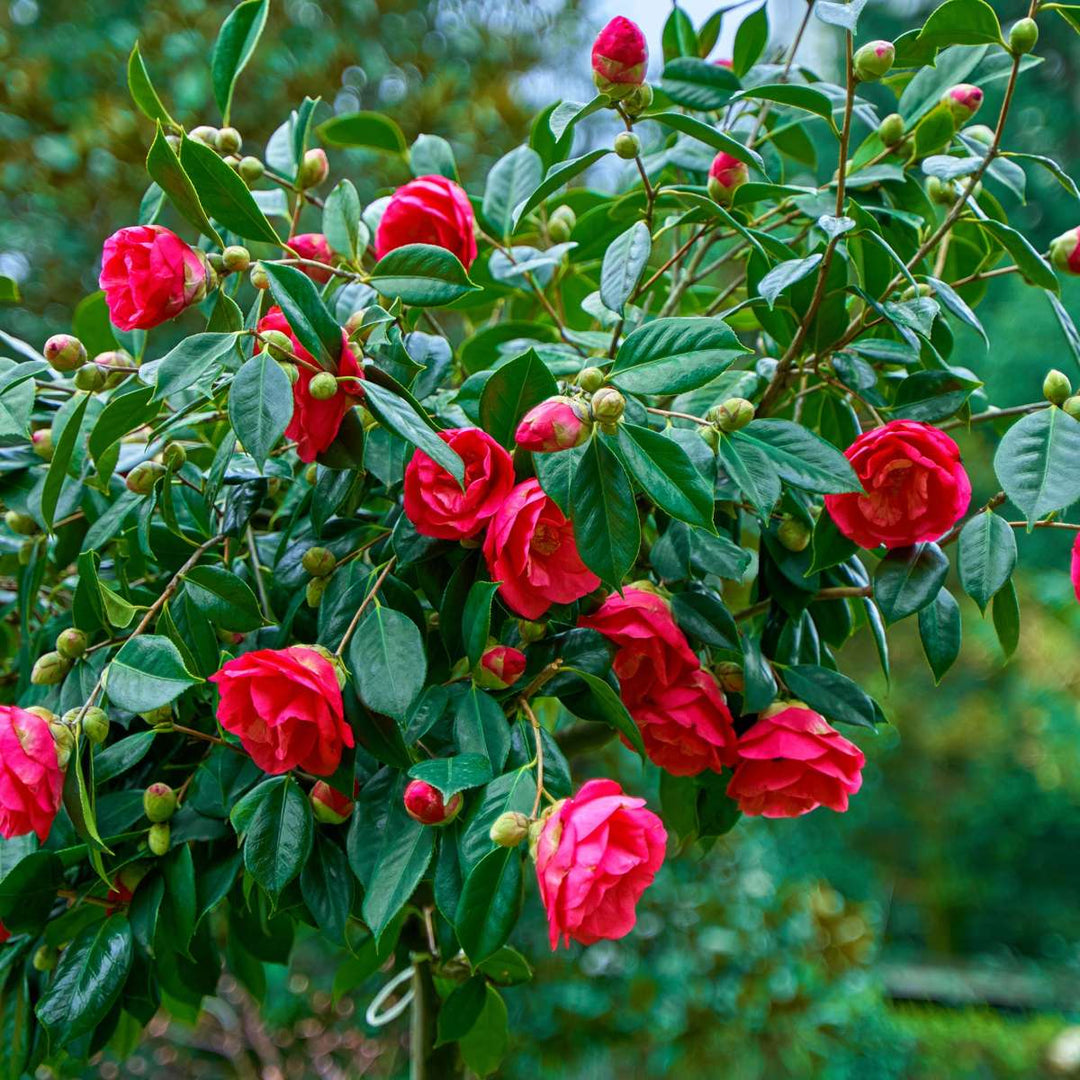When winter winds hush the song of most blossoms, the camellia rises in quiet majesty. Its rich green leaves gleam with vitality, and its blooms—layered like porcelain teacups—grace the garden in shades of crimson, pink, and white. Native to East Asia and long admired in the gardens of Japan and China, the camellia brings elegance and unexpected color to the colder seasons.
Whether grown as a specimen shrub, part of a woodland border, or pruned into a hedge, the camellia rewards patience and proper care with stunning floral displays. Let us explore the cultivation of this regal plant, so it may become a crown jewel in your own garden.

Portrait of the Camellia
Camellias belong to the Theaceae (tea) family and comprise around 300 species, though Camellia japonica, Camellia sasanqua, and Camellia reticulata are most commonly grown for ornamental purposes. These evergreen shrubs and small trees are native to the woodlands of China, Korea, and Japan.
Highly regarded for their glossy leaves and long-lasting blooms, camellias symbolize admiration, perfection, and devotion—frequent subjects in art and literature.
Foliage and Form
Camellias form dense, rounded shrubs or small trees with dark green, leathery leaves, typically oval with serrated edges. Their tidy form and evergreen presence make them a year-round asset in the garden.
Depending on species and pruning, camellias range in height from 1.2 metres (4 ft) to over 6 metres (20 ft). Some varieties are compact and ideal for containers, while others grow into broad, elegant specimens.
Blooms and Fragrance
Camellia flowers vary in size from 5 to 13 cm (2–5 in) across and come in single, semi-double, double, and peony forms. Their colors span delicate whites, rosy pinks, crimsons, and even striped or variegated combinations.
Most camellias are unscented, though some cultivars of C. sasanqua and hybrids carry a light fragrance. Bloom time depends on the species: C. sasanqua blooms in autumn, while C. japonica and C. reticulata flower from late winter to early spring.
The Right Time to Plant and Care for Camellias
Camellias are best planted with care and pruned thoughtfully to maintain shape and encourage flowering. Their seasonal cycle is distinct, with precise windows for planting and light grooming.
| Month | Planting | Flowering | Pruning |
|---|---|---|---|
| January | ❌ | ✅ (japonica, reticulata) | ❌ |
| February | ✅ (in warm zones) | ✅ | ❌ |
| March | ✅ | ✅ (late varieties) | ✅ (after bloom) |
| April | ✅ | ❌ | ✅ |
| May | ✅ | ❌ | ✅ |
| June | ✅ | ❌ | Light shaping only |
| July | ✅ (mild climates) | ❌ | Light shaping only |
| August | ❌ | ❌ | ❌ |
| September | ✅ (cool climates) | ❌ | ❌ |
| October | ✅ | ✅ (sasanqua) | ❌ |
| November | ✅ | ✅ (sasanqua) | ❌ |
| December | ❌ | ✅ (sasanqua) | ❌ |
✅ = Recommended ❌ = Not advised
Ideal Watering, Sunlight, and Environment for Camellias
Watering
Camellias enjoy consistently moist but well-drained soil. They are not drought-tolerant and need regular watering, particularly in the first two years. Once established, water them during dry spells. Avoid soggy conditions, which can lead to root rot.
Sunlight
Camellias prefer dappled light or morning sun with afternoon shade. Too much direct sun can scorch the leaves and reduce bloom quality, especially in hotter climates. Camellia sasanqua tolerates more sun than C. japonica.
Indoor vs Outdoor
Camellias are generally best suited to outdoor environments, thriving in woodland gardens or along north- and east-facing walls. However, smaller cultivars can be grown in containers and brought under cover in colder regions or to protect from frost.
Temperature
Camellias prefer cool, temperate climates. Most varieties are hardy in USDA zones 7–9, though some cultivars can tolerate zone 6 with winter protection. Protect flower buds from harsh frosts with fleece or placement near a sheltered wall.
Ideal Soil Conditions for Growing Camellias
| Soil Feature | Optimal Condition | Why It Matters |
|---|---|---|
| Soil Type | Loamy, well-drained, and humus-rich | Encourages strong root development and retains moisture without waterlogging. |
| Texture | Light, crumbly, and aerated | Prevents compaction and supports healthy root growth. |
| Drainage | Free-draining but moisture-retentive | Camellias dislike both drought and sogginess. |
| Moisture | Evenly moist | Avoid dry spells, especially during bud formation. |
| Soil pH | Acidic (5.5–6.5) | Camellias are ericaceous and suffer in alkaline soils. |
Common Problems & Solutions
| Issue 🐾 | Symptoms 🔍 | Solutions 🛠️ |
|---|---|---|
| Bud Drop 💧 | Buds fall before opening | Avoid overwatering or underwatering; protect from cold winds |
| Yellow Leaves 🍂 | Older leaves yellow, veins pale | Check for alkaline soil; amend with ericaceous compost or iron |
| Tea Scale Insects 🐞 | White fluff under leaves, yellow blotching | Prune infected areas, use horticultural oil |
| Root Rot 💦 | Wilting, brown roots, slow growth | Improve drainage, avoid waterlogging |
| Leaf Sunburn ☀️ | Brown, crispy leaf edges | Provide dappled shade, especially in hot climates |
Quietly regal and infinitely graceful, the camellia brings color and form when the world seems asleep. With its glossy leaves, structured growth, and out-of-season blooms, it rewards thoughtful care with years of dignified beauty.